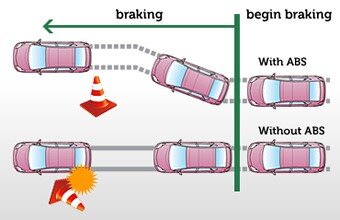ABS operates by preventing the tires from locking up, allowing you to maintain steering control
ABS brakes or an Anti-lock Braking System is pretty self-explanatory. It’s an anti-locking system for your brakes, which means the system modulates brake pressure at each wheel in an emergency to prevent the wheels from locking and therefore losing their grip with the road surface. The wheels of the car do not stop turning until the car physically stops. Since the wheels of the car are turning as long as the car is moving if you turn your steering wheel left or right the car will change directions and go that way.
Before ABS brakes you had to pick in an emergency between braking or turning to avoid the crash. With ABS brakes you can brake and turn to avoid a crash, which is a huge advantage.
When the ABS system kicks in you’ll generally feel a pulsating from the brake pedal itself and you’ll hear a grinding noise coming from the car. This is the system working correctly, engaging the ABS system does not hurt the car at all
The ABS also doubles as an efficient traction controller. Oftentimes, in extreme weather conditions, such as snow or a torrential downpour, the wheels have difficulty gripping the road. The ABS gives the vehicle and the driver more traction while stopping to keep driving safely.
Some vehicle systems are equipped with intelligent automatic self-braking features governed by software and a radar. This feature is located on the front side of the car where it can detect when a vehicle is about to collide with another car or object. The system will then alert the driver of danger and activate the ABS, which will bring the vehicle to a halt quickly.
The ABS technology has been around for more than 20 years, and while most automobiles have it, there are some that still don’t. One good way to check if the new or used car you’re buying has an ABS is to switch on the ignition and look for an ABS indicator light on the dashboard. You should also have the system checked if you’re buying a used vehicle to make sure that the ABS is still running smoothly. The last thing you’d want is a system that no longer kicks in when you need it the most.






